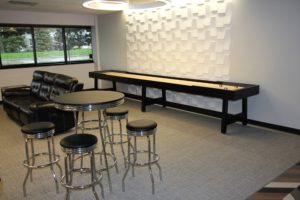
Workplace Employee Break Room Antidote to Stress
Management enjoys the positive effect of healthy diversions
Most of us know about being on the hamster treadmill of life and work. Depending on the job, it comes sooner or later; the repetitious nature of our job description gnaws away at our patience and the day seems longer than 8 hours. Having to work, we find ways to cope. And while coping works to a point, the routine is getting to us even as we console ourselves with thoughts that what we’re doing is building character.
We’re taking our breaks as advised, but they’re so small, we don’t think they can be managed. And breaks don’t seem to refresh our brains because it’s hard to detach ourselves from what we were doing just moments before. Having longer breaks sounds great, but we’ll have a harder time getting back into the groove. So how can we take that sliver of time and fashion it into something that improves how we do things?
Value of mini-breaks noted
Research suggests that breaks, even very short ones are beneficial. In a 2014 study by researchers at Kansas State University who contacted 72 full-time employees from a variety of industries – those who spent one or two minutes during breaks in their day playing games such as Candy Crush on their phones reported being happier than their peers. Employees reported spending 22 minutes playing video games during an eight-hour workday.
Conventional employee wellness programs failing
According to recent figures, about 75% of employees in the U.S. have access to employer-sponsored wellness programs, but participation remains very low. Increased healthcare costs and diminishing worker productivity are making employee wellness programs more important than ever. Though many traditional employee health initiatives are largely ineffective, there is hope; employee wellness programs are available that use technology and game mechanics to increase engagement and reward participation.
Good diversions, not distractions
Diversions are planned activities that engage and entertain. Distractions start as reactions to things around us; if not watchful, they’ll invade our subconscious and cause us to lose deadlines. Also, the less disciplined we are, the more distraction-prone we are. Good diversions, in order to keep them from turning into distractions, are fully intentional and appropriate to the situation at hand. A poorly conceived diversion will disrupt and distract. A well-planned out diversion has exact parameters and offer something to everyone. Goofing off is a product of being easily distracted and might be a sign that it’s time to start looking into developing smart diversions.
Finding a common ground through diversion
We’re all very unique creatures, but have some common features that make us the social beings we are. At work, we’re surrounded by people with different skill levels and backgrounds. Placed in the same room or office together, we’re naturally curious to know something about others, and shy people aren’t exempt from being curious. The curiosity comes from wanting to relate, to feel accepted, and it’s about learning tolerance, something managers like to encourage. It’s natural to want to forge a common ground with coworkers, but the means to do that aren’t always in place at work. Hence, the well-planned diversion provides a way employees can interact in safe ways and gives everyone a chance to get lost for a few minutes each day.
A well-chosen diversion is one that offers easy access, is easy to control, and sets a high standard for what’s appropriate activity during breaks and downtime. It also has universal appeal, so no matter what people’s backgrounds are, the activity will be a hit.
The Play Instinct
Wherever time is on short supply, a diversionary activity that has the greatest potential to relieve and lift the mind has a strong element of play attached to it. The element of play is like a change of scenery as it provides such a potent diversion from the tedium of work that it’s like taking time off for a stroll in the park. So, while the “all work and no play” employers make few allowances for self-expression and fun on the job, they’re not giving their people enough breathing space. Play isn’t strictly a “kid thing” but when kids don’t play, we fear there’s something wrong. When adults don’t play, we’ve accepted that as normal even though adults complain endlessly about feeling bored, stressed out and unfulfilled.
Not machines, people have a need for frequent scene changes, to experience things from another angle, or to use a different part of the brain in order to freshen the attitude. Because most jobs require a specialized skill set that uses the brain in a pattern style way of thinking over long stretches at a time, stress levels shoot up when there’s no handy relief valve nearby.
As technology has entered our lives in a major way, our interactions with machines has greatly increased, but our need for personal growth and meaningful work is unchanged.
The break now seems to be a bigger deal than imagined; we just weren’t managing it right. So instead of repeating the same old daily routine where work and break are barely indistinguishable, we change the scene to one that doesn’t resemble work so much. The “scene” in this case can be literal or virtual; what matters is that the chosen activity engage the mind in a playful and restive way. The level of engagements can range from passive (video games, crossword puzzles, etc.) to more active pursuits that engage more senses (light exercise, shuffleboard tables, ping pong, etc.)
Shuffleboard Tables: antidote to stress

Your play-at-work options are a matter of management enlightenment, but employees can feel free to broach the subject because the benefits are clear and measurable. The more active the play level, the better, but because of time limits, it can’t involve set-up time or driving to some facility across town. Looking for the perfect solution that offers easy access and simplicity, some managers have discovered the merits of owning a shuffleboard table.
Shuffleboard table or not, employers who put in a program of play activity see employees more sociable, cooperative and in a relaxed frame of mind sustained over long stretches of time. Employers also see improvements in greater employee retention, loyalty and production. In short, employers who have organized on-site diversions have seen an overall improvement in employee satisfaction and job culture assimilation resulting in a win-win situation.
Levels of play engagement
Returning to the passive and active levels of play engagement, all levels produce favorable results, but the more active pursuits deliver best results for employee satisfaction. The more passive diversions are more sedentary and solitary; one could stay at the same desk and not interact with anyone. A video game or crossword puzzle might alter the minds cape for a bit, but it’s all done in a vacuum and there’s no lasting afterglow on returning to that computer monitor.
Passive thinking, active playing
When we engage in a playful diversion session, our thoughts drift to the passive thinking mode; we haven’t completely stopped thinking about work, but it’s put on a more relaxed level – in the background, and as we’re engaged in playful activity, the mind is freed up long enough to find solutions to problems. Studies have shown how even 5 minutes spent playing a game during a break can be an efficient method of problem solving and creative thinking. Stepping away from a tricky task for a few minutes of gaming might spur a new perspective on a business problem or help to reset your mind during an especially difficult day, say experts.
Active level best for stress reduction
A more active level of play could involve table shuffle boarding, ping pong or, pool to name a few because they involve a bit of skill and competition, concentration and anticipation act as motivators. Since the shuffleboard table can be provided in-house, has few moving parts and is the safest alternative, we’ll stay with that. Although the skill and competitive aspects of table shuffle boarding is very mild compared to some serious sport activity, it provides a system of playful competition that effectively diffuses tension as it welcomes in a needed change of scenery. Another benefit is it can be done at any age.
How management is introducing gamification to the work place
According to management experts, introduction of healthy diversions in the work place is simply good business, not only for employee satisfaction – it’s transforming business models everywhere by creating new ways to extend all relationships and promote customer and employee loyalty. Called “gamification” in management circles, it’s combined with research on motivation and data generated by user interactions. Gamification empowers businesses to create distinction and loyalty, and table shuffle boarding is seen as an ideal modality to achieve gamification at the work place.
New crop of employees already plugged in
Millennials, or the “always on” generation grew up playing games all of the time. In surveys of entrepreneurs and managers, the younger set of employees coming up through the ranks are seen as unsettled and difficult to manage, expecting foosball tables and access to a video game. Since the work force is always ageing, management must be cognizant of trends in the new playing field and attempt to meet recruit expectations in a competitive industry. A shuffleboard table, when compared to electronic entertainments like Xbox and the like, offers far greater opportunities for social interaction and reduces antisocial behavior spawned by solitary activity.
Not more vacation time, more games

According to A Guide for Employee Wellness put out by Technology
Advice, games are the key to better employees, more effective teams, and improved productivity. After they compiled research on how games impact the brain, it appears that the best way to increase productivity is not in providing more vacation, better benefits or bigger paychecks. Instead, the studies conclude you should encourage your employees to play more games! You might even want to set up a workplace shuffleboard league or tournament read here for more details.



